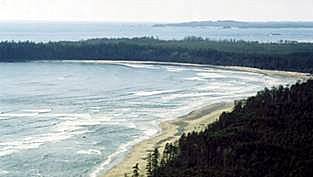 Terrific Tofino: the Esowista Peninsula is perched in the edge of the North America Continent. Next stop Japan! At the north end of the Peninsula is the town of Tofino, located in a protected harbour. Just to the North, you will also find protected waters, and directly offshore is the Wild West Coast.
Terrific Tofino: the Esowista Peninsula is perched in the edge of the North America Continent. Next stop Japan! At the north end of the Peninsula is the town of Tofino, located in a protected harbour. Just to the North, you will also find protected waters, and directly offshore is the Wild West Coast.
Photo, left, the beaches go on forever – Tofino BC, courtesy of Ron Kirstein.
The constant ocean surge in this area keeps the surf breaking on expansive white sandy beaches. In winter, waves can reach up to 50 feet in height! North of Tofino, you'll find the Ahousaht First Nations Community, Cougar Annie's Gardens and Hot Springs Cove, and just across the harbour you'll find Optisat First Nations Village on Meares Island.
Before you enjoy all the exciting tourist activities Tofino has to offer, you must first find a place to stay. Since nearly one million visitors flock to this paradise each summer, it is best to book in advance.
Activities in Tofino: whale watching is the first of the must do's while in Long Beach. Our guide was John Forde of the Whale Centre. A seasoned veteran in the whale watching business, he offers a number of other services as well, such as Hot Springs Cove tours, bear watching, bird watching, and fishing. Experience the thrill of seeing whales, otters, bears, and birds in their natural habitat of beautiful Clayoquot Sound. 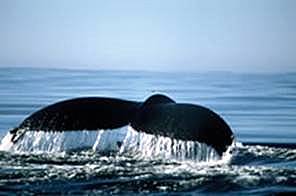 Cruise through the spectacular waters on John's 24' Boston Whaler, searching for Orcas, Humpback Whales, Sea Lions and Dahl's Porpoises. Approximately 18,000 Grey whales pass by Esowista Peninsula on their way to food sources along the North American coast to Alaska. John's a master skipper who knows the area like the back of his hand. For a 2-1/2 hour cruise, he manoeuvres his sturdy boat through the powerful water with the skill of an artisan, all the while providing a running commentary of what you're seeing. Prior to our trip we were treated to a slide show of some of John's best photos, elaborating on what was in store for our Eco-tour of the area. Don't forget your camera, binoculars and warm clothes!
Cruise through the spectacular waters on John's 24' Boston Whaler, searching for Orcas, Humpback Whales, Sea Lions and Dahl's Porpoises. Approximately 18,000 Grey whales pass by Esowista Peninsula on their way to food sources along the North American coast to Alaska. John's a master skipper who knows the area like the back of his hand. For a 2-1/2 hour cruise, he manoeuvres his sturdy boat through the powerful water with the skill of an artisan, all the while providing a running commentary of what you're seeing. Prior to our trip we were treated to a slide show of some of John's best photos, elaborating on what was in store for our Eco-tour of the area. Don't forget your camera, binoculars and warm clothes!
Other Must Do Activities in Tofino:
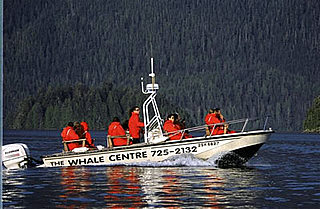 Picture, right, the Boston Whaler – Tour Boat, (photo courtesy of John Forde.)
Picture, right, the Boston Whaler – Tour Boat, (photo courtesy of John Forde.)
Surf: Try Surf Sister — Tofino's surfing school for women, and Live to Surf on the highway just before Tofino, where you can rent boards and get good info on the best waves in the area.
Hike: Lots of spectacular hiking trails in the Pacific Rim National Park. Go to the Park Interpretive Centre at Wichaninnish Beach to pick up trail maps and ask for suggestions.
Big Trees: Take a water taxi to Meares Island and take the boardwalk trail to some 'monster' trees.
Hot Springs Cove: Visit by boat or float plane. The naturally steaming hot springs are 2.4 km on a boardwalk from the docks. A great experience! There are two accommodations at Hot Springs Cove – The Inchanter ) and Hot Springs Lodge 1-866-670-1106
Beach Walks: Beachcombing, long walks, sunset watching, relaxing in the sun, listening to the waves – take your pick. There are miles and miles of white sand beaches.
Sea Kayaking: Try Tofino Sea Kayaking and paddle through the protected waters of Clayoquot Sound. Camp on sandy beaches and take in the wildlife.
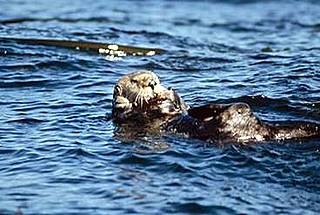 Photo, left, a sea otter near Tofino, (photo courtesy of John Forde)
Photo, left, a sea otter near Tofino, (photo courtesy of John Forde)
Fishing: Try deep-sea fishing or fish protected inlets. Bring your own boat or try one of the local charter companies such as Ospray Charters. Bear Watching: You have opportunities to see bears driving on the highway into Tofino, on backroad excursions, while kayaking (go at low tides), and on boat tours. Check out the Whale Centre for more info.
Native Canoe Experience: Check out Tla-ook Cultural Adventures.
Scuba Diving: Bring your own gear and charter a local boat.
Bird Watching: Check out “Just Birding”, a local bird watching company, or charter John Forde's Whale Centre. John has excellent knowledge of local birds.
Golf: Go to Long Beach Golf Course.
Ahousaht: Take the water taxi to this Native Village and walk the boardwalk trail.
Cougar Annie's Garden: Fly in to these exciting and unique horticultural gardens and learn about the history of this unique lady. Ocean Outfitters (250-725-2866) also provides day visits to Cougar Annie's garden on Wednesday and Sundays. Their boat departs Tofino at 10:00 am, returning at 4:00 PM. Tofino Air can fly you there (1-866-486-3247) Roy Vickers: Visit Roy's Eagle Aerie Gallery and check out the Native Art of world famous artist Roy Henry Vickers in the traditional cedar longhouse gallery in Tofino.
Ron Kirstein is the owner of a Canadian Travel & Tourism Web site (since 1995). Ron has travelled the length and breadth of Vancouver Island BC Canada in search of adventures – see – http://tourismmall.victoria.bc.ca/travelmagazine

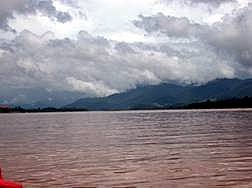 – see picture right of the Mekhong which shows Laos to the right, Burma to the left and Thailand behind.
– see picture right of the Mekhong which shows Laos to the right, Burma to the left and Thailand behind. 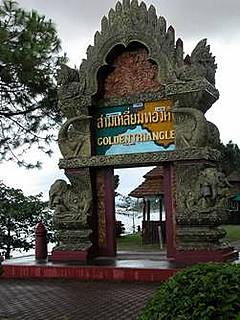 Now, the main thing to do in the Golden Triangle area is to take a boat down the Mekhong (see photo above.) There are oodles of long tail boats are available for hire here and you get to wear a life jacket. Cruising up and down the Mekong River allows visitors a glimpse of village life in the many riverside settlements – particularly in Laos where you can step off and for 15 baht visit a small market which sells bootleg cigarettes, snakes inexplicably coiled in whisky jars (see photo below right) and various items of clothing. Technically you are in
Now, the main thing to do in the Golden Triangle area is to take a boat down the Mekhong (see photo above.) There are oodles of long tail boats are available for hire here and you get to wear a life jacket. Cruising up and down the Mekong River allows visitors a glimpse of village life in the many riverside settlements – particularly in Laos where you can step off and for 15 baht visit a small market which sells bootleg cigarettes, snakes inexplicably coiled in whisky jars (see photo below right) and various items of clothing. Technically you are in 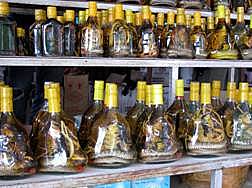
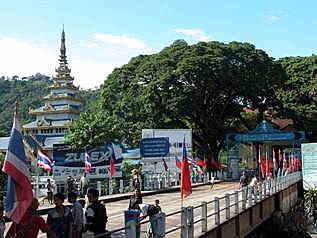 Mae Sai (or Maesai) is the northern most district of
Mae Sai (or Maesai) is the northern most district of 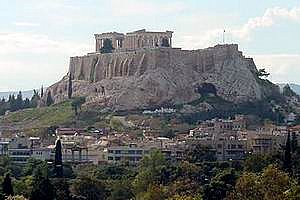 The Acropolis is the one historical site you can't miss. You can take a tour or wander up there yourself but during the summer, whatever you do, unless it is overcast, go early or late in the day. It can get very hot up there and gasping for breath can take way from your ability to marvel at the greatest of all archaeological sites. Getting to the Acropolis is easy and more pleasant than ever because the large avenues which border the south and west of the site (Apostolou Pavlou in Thission and Dionissiou Areopagitou in Makrianni) have been turned into giant pedestrian streets with cafes and restaurants and the walk is quite pleasant. From the Plaka and Monastiraki side it has always been a car-less, enjoyable walk and all you have to do is walk uphill from wherever you are and when you get to the top and there are woods instead of buildings, and steps, take a right.
The Acropolis is the one historical site you can't miss. You can take a tour or wander up there yourself but during the summer, whatever you do, unless it is overcast, go early or late in the day. It can get very hot up there and gasping for breath can take way from your ability to marvel at the greatest of all archaeological sites. Getting to the Acropolis is easy and more pleasant than ever because the large avenues which border the south and west of the site (Apostolou Pavlou in Thission and Dionissiou Areopagitou in Makrianni) have been turned into giant pedestrian streets with cafes and restaurants and the walk is quite pleasant. From the Plaka and Monastiraki side it has always been a car-less, enjoyable walk and all you have to do is walk uphill from wherever you are and when you get to the top and there are woods instead of buildings, and steps, take a right. 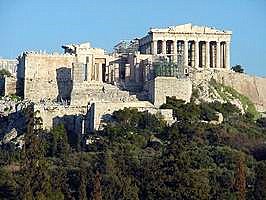 After climbing the steps you are at the entrance, or the Propylaea, which was completed in 432 just before the outbreak of the Peloponnesian wars. The main architect was Mnesicles, a colleague of Phidias. To your left is the Pinacotheca and a Hellenistic pedestal and on the right the tiny temple to Nike Athena or the Athena of Victory which commemorates the Athenians victory over the Persians. This small temple stands on a platform that overlooks the islands of Saronic Gulf and used to house a statue of Athena. It was dismantled by the Turks in 1686 so they could use the platform for a large cannon. It was rebuilt between 1836 and 1842 and again taken apart and rebuilt in 1936 when it was discovered that the platform was crumbing. If you looking from the propylaea towards Pireaus on a clear day you can see ships waiting outside the port of Pireaus, the islands and the mountains of the Peloponessos beyond.
After climbing the steps you are at the entrance, or the Propylaea, which was completed in 432 just before the outbreak of the Peloponnesian wars. The main architect was Mnesicles, a colleague of Phidias. To your left is the Pinacotheca and a Hellenistic pedestal and on the right the tiny temple to Nike Athena or the Athena of Victory which commemorates the Athenians victory over the Persians. This small temple stands on a platform that overlooks the islands of Saronic Gulf and used to house a statue of Athena. It was dismantled by the Turks in 1686 so they could use the platform for a large cannon. It was rebuilt between 1836 and 1842 and again taken apart and rebuilt in 1936 when it was discovered that the platform was crumbing. If you looking from the propylaea towards Pireaus on a clear day you can see ships waiting outside the port of Pireaus, the islands and the mountains of the Peloponessos beyond. 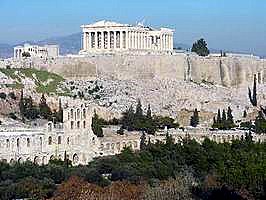 The Parthenon and other main buildings on the Acropolis were built by Pericles in the fifth century BC as a monument to the cultural and political achievements of the inhabitants of Athens. The term acropolis means upper city and many of the city states of ancient Greece are built around an acropolis where the inhabitants can go as a place of refuge in times of invasion. It's for this reason that the most sacred buildings are usually on the acropolis. It's the safest most secure place in town. As little as 150 years ago there were still dwellings on the Acropolis of Athens. Those of you who have read Aristophanes will recall that in Lysistrata the women have Athens barricaded themselves in the fortress in protest, being tired of their men going to war against Sparta. Depriving them of sex, cooking and care it was a terrific strategy that might even work today. Regardless, the play opened the door to the subject of sexual frustration in comedy and without it we might not have Woody Allen. Nowadays there are still protests which occasionally take place by site employees closing the Acropolis to tourists, some of whom have waited a lifetime to come to Greece. Thankfully these are rare and of short duration.
The Parthenon and other main buildings on the Acropolis were built by Pericles in the fifth century BC as a monument to the cultural and political achievements of the inhabitants of Athens. The term acropolis means upper city and many of the city states of ancient Greece are built around an acropolis where the inhabitants can go as a place of refuge in times of invasion. It's for this reason that the most sacred buildings are usually on the acropolis. It's the safest most secure place in town. As little as 150 years ago there were still dwellings on the Acropolis of Athens. Those of you who have read Aristophanes will recall that in Lysistrata the women have Athens barricaded themselves in the fortress in protest, being tired of their men going to war against Sparta. Depriving them of sex, cooking and care it was a terrific strategy that might even work today. Regardless, the play opened the door to the subject of sexual frustration in comedy and without it we might not have Woody Allen. Nowadays there are still protests which occasionally take place by site employees closing the Acropolis to tourists, some of whom have waited a lifetime to come to Greece. Thankfully these are rare and of short duration. 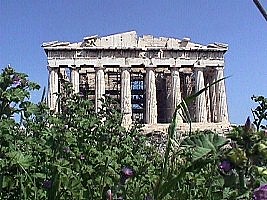 The best time to go up there is the late winter or spring when even this stone mountain is not immune to the proliferation of grass and wildflowers which seem to burst from every crack. Even in December, January and February the Acropolis can be surprisingly green. Even having seen a thousand photographs one is still not prepared for the immensity of the Parthenon. The building was designed by the architects Kallikrates and Iktinos as the home of the giant statue of Athena. It took 15 years to build and was completed in 438 BC and is probably the most recognizable structure in the world next to the golden arches of McDonalds. From a temple it became a church, a mosque and finally as a storage facility for Turkish gunpowder. In 1687 the Venetians bombarded it from below. A cannon ball hit the gun powder and blew it up.
The best time to go up there is the late winter or spring when even this stone mountain is not immune to the proliferation of grass and wildflowers which seem to burst from every crack. Even in December, January and February the Acropolis can be surprisingly green. Even having seen a thousand photographs one is still not prepared for the immensity of the Parthenon. The building was designed by the architects Kallikrates and Iktinos as the home of the giant statue of Athena. It took 15 years to build and was completed in 438 BC and is probably the most recognizable structure in the world next to the golden arches of McDonalds. From a temple it became a church, a mosque and finally as a storage facility for Turkish gunpowder. In 1687 the Venetians bombarded it from below. A cannon ball hit the gun powder and blew it up. 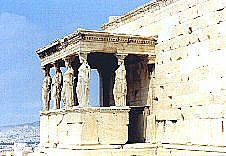 The Erecthion sits on the most sacred site of the Acropolis where Poseidon and Athena had their contest over who would be the Patron of the city. Poseidon thrust his trident into the rock and a spring burst forth, while Athena touched the ground with a spear and an olive tree grew. Athena was declared the victor and the great city of Athens was named for her while Poseidon was given a small village in Syros after it was discovered he had merely ruptured a water main. (not really).The building itself contains the porch of the maidens or Caryatids which are now copies, four of which have been placed in the Acropolis museum, hopefully to be reunited with a fifth taken from the Acropolis by Lord Elgin and put in the British Museum more than a century ago.
The Erecthion sits on the most sacred site of the Acropolis where Poseidon and Athena had their contest over who would be the Patron of the city. Poseidon thrust his trident into the rock and a spring burst forth, while Athena touched the ground with a spear and an olive tree grew. Athena was declared the victor and the great city of Athens was named for her while Poseidon was given a small village in Syros after it was discovered he had merely ruptured a water main. (not really).The building itself contains the porch of the maidens or Caryatids which are now copies, four of which have been placed in the Acropolis museum, hopefully to be reunited with a fifth taken from the Acropolis by Lord Elgin and put in the British Museum more than a century ago. 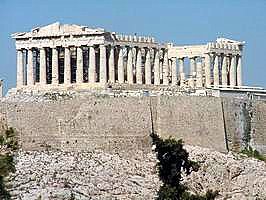 A question in my mind is why not rebuild the Parthenon to its former glory? It is not as if the destruction of it is sacred history that must be preserved, in fact the 300 years since the explosion is a relatively short time-span in the history of the building. Much of the Parthenon has been taken apart and put back together with pieces being replaced or clamped to remedy the wear and tear of centuries, in particular the last 20 or so years of air pollution. As it stands now, though it is a tribute to the glorious past and the achievement of the Ancient Athenians it is also at the same time a reminder that whatever is good in man is eventually overcome by ignorance, war and a hunger for domination. I say rebuild the entire Acropolis as an inspiration that whatever is wrong with the world can be righted. (Until some idiot blows it up again).
A question in my mind is why not rebuild the Parthenon to its former glory? It is not as if the destruction of it is sacred history that must be preserved, in fact the 300 years since the explosion is a relatively short time-span in the history of the building. Much of the Parthenon has been taken apart and put back together with pieces being replaced or clamped to remedy the wear and tear of centuries, in particular the last 20 or so years of air pollution. As it stands now, though it is a tribute to the glorious past and the achievement of the Ancient Athenians it is also at the same time a reminder that whatever is good in man is eventually overcome by ignorance, war and a hunger for domination. I say rebuild the entire Acropolis as an inspiration that whatever is wrong with the world can be righted. (Until some idiot blows it up again). 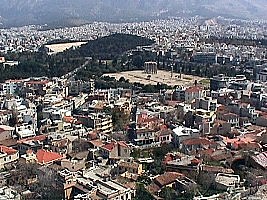 My favourite spot is at the flag where Athens stretches out endlessly below. You can see the Plaka beneath you, the ruins of the giant Temple of Olympian Zeus and the Olympic stadium nestled in a pine covered hill, an island of green in a sea of concrete. To the left of the stadium is the Zappion building and the National Gardens. To the right of the stadium you can see another large patch of green which is the First Cemetery. The Acropolis is a great place to get your bearings and get an understanding of the layout of the city. In fact the more you know Athens the more interesting it is to come up here and see familiar landmarks.
My favourite spot is at the flag where Athens stretches out endlessly below. You can see the Plaka beneath you, the ruins of the giant Temple of Olympian Zeus and the Olympic stadium nestled in a pine covered hill, an island of green in a sea of concrete. To the left of the stadium is the Zappion building and the National Gardens. To the right of the stadium you can see another large patch of green which is the First Cemetery. The Acropolis is a great place to get your bearings and get an understanding of the layout of the city. In fact the more you know Athens the more interesting it is to come up here and see familiar landmarks. 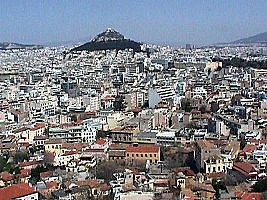 If you stand by the flag and look to your left you will see Mount Lycabettos rising from the neighbourhood of
If you stand by the flag and look to your left you will see Mount Lycabettos rising from the neighbourhood of 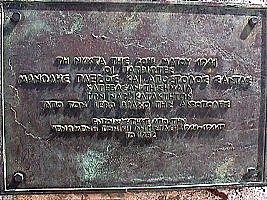 The plaque by the flag commemorates Manolis Glezos and Apostolis Santas, the two eighteen year-old heroes who tore down the Nazi flag flying from the Acropolis on the night of May 30th, 1941. It is of particular interest because these names are known not only by Greeks, but by many Europeans, because this act of courage and resistance to Nazi oppression was an inspiration to all subjected people. Later through reading the book
The plaque by the flag commemorates Manolis Glezos and Apostolis Santas, the two eighteen year-old heroes who tore down the Nazi flag flying from the Acropolis on the night of May 30th, 1941. It is of particular interest because these names are known not only by Greeks, but by many Europeans, because this act of courage and resistance to Nazi oppression was an inspiration to all subjected people. Later through reading the book 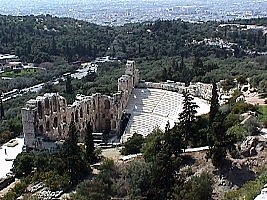 Below the Acropolis is the theatre of Herod Atticus built by the Romans in 161 AD and still used today for classical concerts, ballet, performances of high cultural value and Yanni. Further on is the Theatre of Dionysius the first stone theatre and home to Sophocles, Aeschylus, Euripides and Aristophanes. It was rebuilt around 342 BC by Lykourgos and then enlarged by the Romans to be used for gladiator fights. In July of 2003 I saw Jethro Tull here. It was the first rock concert held in the ancient theatre and though perhaps some people hope it was the last I would be happy to see more. How about Deep Purple with the Royal Philharmonic Orchestra performing Jon Lord's Concerto for Group and Orchestra? Maybe Procul Harum? Emerson, Lake and Palmer? The Stooges? Where's Leonard Cohen when you really need him?
Below the Acropolis is the theatre of Herod Atticus built by the Romans in 161 AD and still used today for classical concerts, ballet, performances of high cultural value and Yanni. Further on is the Theatre of Dionysius the first stone theatre and home to Sophocles, Aeschylus, Euripides and Aristophanes. It was rebuilt around 342 BC by Lykourgos and then enlarged by the Romans to be used for gladiator fights. In July of 2003 I saw Jethro Tull here. It was the first rock concert held in the ancient theatre and though perhaps some people hope it was the last I would be happy to see more. How about Deep Purple with the Royal Philharmonic Orchestra performing Jon Lord's Concerto for Group and Orchestra? Maybe Procul Harum? Emerson, Lake and Palmer? The Stooges? Where's Leonard Cohen when you really need him? 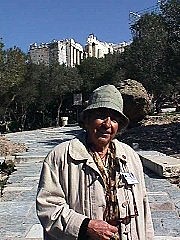 You may notice at the entrance to the Acropolis and the paths leading up to it the licensed guides who for around 50 Euros or so, will give you a tour so that you may leave the area more informed then when you got here. One of the most well-known was Teresa Mitsopoulou, an Archaeologist and writer of some renown. Several of her books are considered controversial by her fellow archaeologists because they seem to prove a link between Chinese and Ancient Greek culture that if correct could change much of what we believe about the past. Theresa has gotten older now and cannot climb the ancient hill as quickly and as easily as she once used to. But she has been described by one travel agent as “… to the Parthenon, what an old monk is to a monastery. If one has the time and patience to sit with her much can be gained. She has been a licensed Acropolis Guide since 1954, in my view a contemporary priestess”. See Theresa's website at
You may notice at the entrance to the Acropolis and the paths leading up to it the licensed guides who for around 50 Euros or so, will give you a tour so that you may leave the area more informed then when you got here. One of the most well-known was Teresa Mitsopoulou, an Archaeologist and writer of some renown. Several of her books are considered controversial by her fellow archaeologists because they seem to prove a link between Chinese and Ancient Greek culture that if correct could change much of what we believe about the past. Theresa has gotten older now and cannot climb the ancient hill as quickly and as easily as she once used to. But she has been described by one travel agent as “… to the Parthenon, what an old monk is to a monastery. If one has the time and patience to sit with her much can be gained. She has been a licensed Acropolis Guide since 1954, in my view a contemporary priestess”. See Theresa's website at 
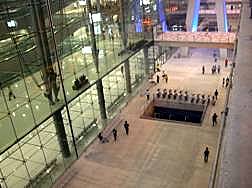 The exterior is made up of huge glass sheets, lit up in blue neon at night. Approaching the airport
The exterior is made up of huge glass sheets, lit up in blue neon at night. Approaching the airport 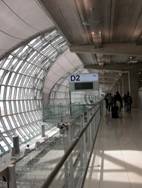 by taxi, it looks a little like a series of low level Sydney Opera houses with beige coloured caterpillar sections fitting together like four extended arms. Inside, it is vast with massive walkways of shops and food outlets, some of which are surprisingly good value, for an international airport.
by taxi, it looks a little like a series of low level Sydney Opera houses with beige coloured caterpillar sections fitting together like four extended arms. Inside, it is vast with massive walkways of shops and food outlets, some of which are surprisingly good value, for an international airport.  Mac is still not very well but is still e-mailing strong. In this month’s Globetrotter e-newsletter, he writes about animals.
Mac is still not very well but is still e-mailing strong. In this month’s Globetrotter e-newsletter, he writes about animals. 
 Cruise through the spectacular waters on John's 24' Boston Whaler, searching for Orcas, Humpback Whales, Sea Lions and Dahl's Porpoises. Approximately 18,000 Grey whales pass by Esowista Peninsula on their way to food sources along the North American coast to Alaska. John's a master skipper who knows the area like the back of his hand. For a 2-1/2 hour cruise, he manoeuvres his sturdy boat through the powerful water with the skill of an artisan, all the while providing a running commentary of what you're seeing. Prior to our trip we were treated to a slide show of some of John's best photos, elaborating on what was in store for our Eco-tour of the area. Don't forget your camera, binoculars and warm clothes!
Cruise through the spectacular waters on John's 24' Boston Whaler, searching for Orcas, Humpback Whales, Sea Lions and Dahl's Porpoises. Approximately 18,000 Grey whales pass by Esowista Peninsula on their way to food sources along the North American coast to Alaska. John's a master skipper who knows the area like the back of his hand. For a 2-1/2 hour cruise, he manoeuvres his sturdy boat through the powerful water with the skill of an artisan, all the while providing a running commentary of what you're seeing. Prior to our trip we were treated to a slide show of some of John's best photos, elaborating on what was in store for our Eco-tour of the area. Don't forget your camera, binoculars and warm clothes!  Picture, right, the Boston Whaler – Tour Boat, (photo courtesy of John Forde.)
Picture, right, the Boston Whaler – Tour Boat, (photo courtesy of John Forde.)  Photo, left, a sea otter near Tofino, (photo courtesy of John Forde)
Photo, left, a sea otter near Tofino, (photo courtesy of John Forde)  This year I was luckier. Despite last years' bombing and some countries still having a travel warning against visiting Indonesia, I was able to go and do the two week workshop in Ubud with Dena. We stayed at Ananda Cottages a little way out of town. Our Shala was at the bottom of the grounds looking out onto beautiful green rice paddies, with ducks quacking away each morning as we did our practice. Twenty five of us from all over the world including UK, South Africa, Australia, New Zealand, Chile and Sweden all here to
This year I was luckier. Despite last years' bombing and some countries still having a travel warning against visiting Indonesia, I was able to go and do the two week workshop in Ubud with Dena. We stayed at Ananda Cottages a little way out of town. Our Shala was at the bottom of the grounds looking out onto beautiful green rice paddies, with ducks quacking away each morning as we did our practice. Twenty five of us from all over the world including UK, South Africa, Australia, New Zealand, Chile and Sweden all here to  learn from one of the worlds best teachers. For 3 hours each morning and also a few afternoons we learned. Dena is very observant and makes small but highly significant changes to our postures, my Urdva Dhanurasana (Backbend) came on wonderfully.
learn from one of the worlds best teachers. For 3 hours each morning and also a few afternoons we learned. Dena is very observant and makes small but highly significant changes to our postures, my Urdva Dhanurasana (Backbend) came on wonderfully.  Another day I went up to Danau Bratan in the north of the island to see the very picturesque temples, which are set on little islands in the lake. This is picture postcard Bali, and despite its popularity there were not that many people there. We also stopped at the Botanical Gardens for a wander round, but it was the wrong time of year for the orchids and the cactus house was locked up.
Another day I went up to Danau Bratan in the north of the island to see the very picturesque temples, which are set on little islands in the lake. This is picture postcard Bali, and despite its popularity there were not that many people there. We also stopped at the Botanical Gardens for a wander round, but it was the wrong time of year for the orchids and the cactus house was locked up. 
 granola is to die for to the extent that I even carted two bags back home with me. A couple of afternoons we went on guided walks with Dena's husband Jack, out into the rice paddies that surround Ubud. Beautiful scenery with the palm trees being reflected in the water of the paddies in the late afternoon sunshine. Locals would shin up trees to pick coconuts for us and local artists would sell their works.
granola is to die for to the extent that I even carted two bags back home with me. A couple of afternoons we went on guided walks with Dena's husband Jack, out into the rice paddies that surround Ubud. Beautiful scenery with the palm trees being reflected in the water of the paddies in the late afternoon sunshine. Locals would shin up trees to pick coconuts for us and local artists would sell their works.